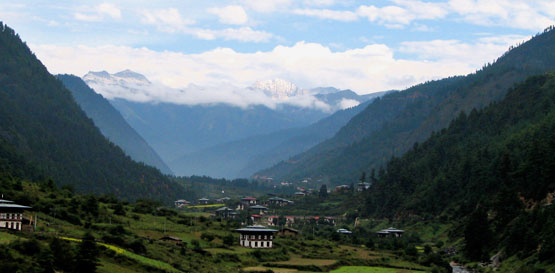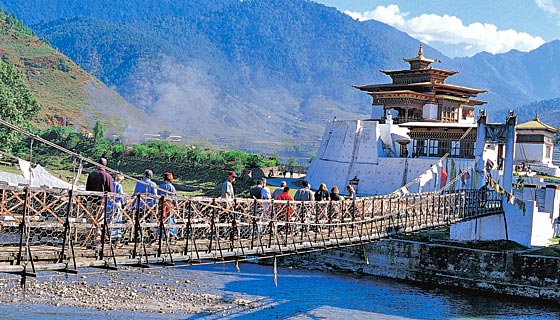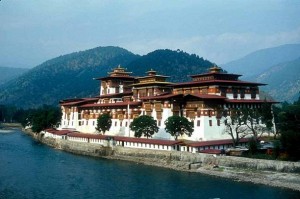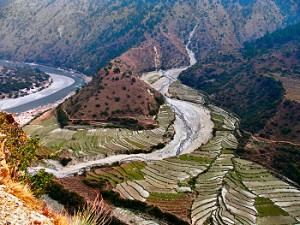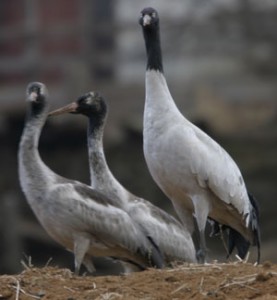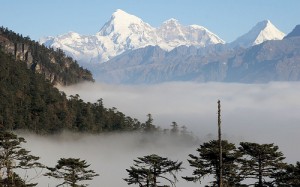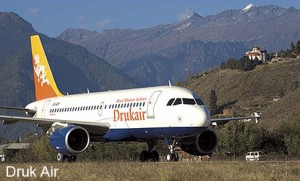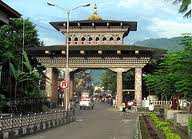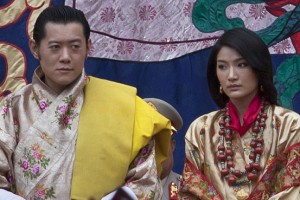The Punakha Dzong, “the palace of great happiness or bliss”
There are many ways to see Bhutan. A short trip for a week or less will introduce you to the world’s last remaining Himalayan kingdom, with visits to the Paro and Thimphu valleys and perhaps an excursion to Punakha, the ancient capital. In Paro you can visit the Ta Dzong National Museum, with its fascinating collection of art, relics and artifacts; the ruined fortress of Drukgyel Dzong where Bhutanese warriors fought in past ages against invaders from Tibet and where Bhutan’s sacred mountain, Jomolhari, towers above the ruins into the sky. One of Bhutan’s most famous sights, Taktsang or the Tiger’s Nest, clings to a 3000 ft high cliff above the Paro valley; it is the place where Guru Rinpoche is said to have flown on a tiger when he brought the Buddhist Dharma from Tibet and India.
Paro – the beginning of your journey Normally, Paro is both entry and Exit point of Bhutan there can be few more charming valleys to be welcomed by, or from which to remember the land of the Thunder Dragon. As you climb down from the aircraft and take your first breath of Bhutanese air, you will be struck by the silence and peace of Paro’s valley. A destination all of its own, Paro is home to the national museum and watchtower to one of the oldest and most celebrated dzong in all Bhutan. At 7, 382 ft Paro is the site of Bhutan’s only airport and is the most beautiful western valley.
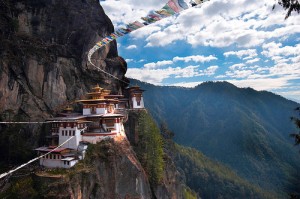
Taktshang-Monastery-Paro
Paro Town is small but one of the most beautiful town in Bhutan. This beautiful valley is home to many of Bhutan oldest monasteries and temples. Mt. Jomolhari (7, 300 M) reigns in white glory at the northern end of the valley whose glacier water forms the Pachu flowing through the valleys.
Apart from commanding a slightly elevated strategic point overlooking the longest stretch of the Paro Valley, Paro Dzong is symbolic as the religious and secular centre of all affairs of the valley. It Is also an architectural wonder, setting the tone for official dzong. Throughout the kingdom and inviting the visitor to wonder at the cultural strength of the kingdom’s heritage. The dzong itself was conceived in the 15th century and finally consecrated In 1646. Above the dzong is the old watchtower which is now home to Bhutan’s national museum. The museum’s collection includes ancient Bhutanese arts and artifacts, weapons and stamps, birds and animals. This is typical of the eclectic beauty of Bhutan – its prized objects bear little relation to each other but as a whole stand together as a history of one of the world’s most pristine people.
It is said that Guru Rinpoche, the father of the Bhutanese strain of Mahayana Buddhism, arrived in the Paro Valley more than a arrived in the Paid Valley more than a millennium ago on the back of a legendary tigress. He meditated for three months in a cave where a monastery was later built and called Taktsang Lhakang or Tiger’s Nest. Visitors to Paro can take a closer look at the monastery by ascending either on foot or by pony for about three hours to Tiger’s Nest. Walkers can enjoy a well-earned rest at a Taktsang Cafeteria situated at a wonderful vantage point of the monastery.
Thimpu – capital of Bhutan Thimphu is a small, charming capital city sandwiched in the heart of the Himalayas. It sits in its own valley fanning out from the river. The skyline hardly changes as new buildings are all constructed under zoning regulations. Thimphu’s development is strictly monitored and buildings cannot exceed a certain height, nor can they be designed in anything but the traditional Bhutanese style.
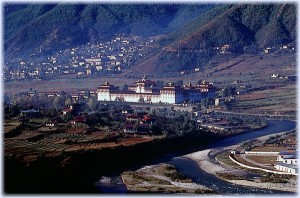
The Beautiful Tashichhoedzong monastery and fortress on the northern edge of the city of Thimpu
Only a sprinkling of cars is ever found along the main street and the capital’s population is not immediately visible. But, if you look, inside the bank or the shop, you will find Thimphu’s people and Bhutan’s heart. Dressed in kho and kira, Thimphu people go about their work methodically, quietly bringing their nation through the growing pains of development and into its own definition of the modem world. Sirntokha Dzong, six kms from the city limits is the kingdom’s oldest dzong which is now used as the Dzongka language school of Bhutan. Bhutan’s most stately and arguably most impressive building is Tashicchodzong, on the banks of the Wangchu (Thimphu River).
The home of the National Assembly and the summer residence of the capital’s venerated monastic community, Tashichodzong is a palatial building overlooking the river on the South side and the city of Thimphu from the North. While foreign visitors are only allowed to enter Tashicchodzong during the annual festival, Its presence and its exterior and grounds provide a delightful spectacle. The dzong is the impressive result of a redesign of the original medieval structure sanctioned by His Majesty Jigme Dorje Wangchuck the 3rd King, when he moved Bhutan’s permanent capital to Thimphu.
The most enjoyable way of passing time in Thimphu is just to wander along its main street. Many of the items on sale are made In India but textiles and the wooden crafts are Bhutanese as are all of the religious products. Thimphu’s weekend market is another chance to watch the way life goes in the kingdom. Here, every weekend, Thimphu’s residents break from whatever it Is that they are doing to come to the market to pick up their weekly stock of vegetables, a copy of Kuensel (the weekly newspaper) and to exchange the week’s gossip. It is a custom as old as the market and one both buyer and seller enjoy. For visitors who can’t share In the gossip, a wander through the stalls reveals mountains of bright red chillies, eggplants and okra, asparagus In season and rice of every size. Traditional Bhutanese masks are sold, as are the carpets more reasonably found in Trongsa.
Another of Bhutan’s loveliest exports is its wide and multifarious collection of stamps. These are best seen in commemorative books inside Thimphu’s central post office. Other places of Interest in Thimphu include the traditional painting school where the age-old styles of Bhutanese painting, including thangka painting, are taught and the Memorial Chorten built in memory of His Majesty, the Third King of Bhutan. The National Library houses a vast collection of books and research documents of Buddhist studies.
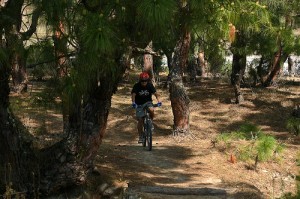
Punakha has excellent mountain biking trails.
Punakha – the winter capital The first stop after leaving Thimphu on the journey East is Dochula Pass at 10, 500 feet. Only 45 minutes from Thimphu, it offers visitors their first glimpse of the Himalayan range. The best time to reach Dochula Is dawn when the clouds are thin and the rhododendron are in season. Then the early morning sun casts breathtaking light on the distant mountains framed in shades of red from the brilliant flowers.The road to Punakha branches off left and curls its way down the valley to the relative lowlands of the Punakha Valley. The town of Punakha does not hold many attractions apart from the glorious dzong which dominates the valley floor. Before Thimphu was made capital of Bhutan, Punakha held the title as Winter capital because of its more temperate climate. Thimphu’s monk body and the Je Khenpo (leader of Bhutan’s religious order) still come to Punakha to pass the Winter. Punakha Dzong was strategically built at the confluence of the Phochu (male) and Mochu (female) rivers by the first Shabdrung of Bhutan, Ngawang Namgyel in 1637. It has been destroyed by four fires and an earthquake in 1897 and has frequently been devastated by flood water coming from the great northern glaciers. The Dzong has now been fully restored to its original splendor.
Phuntsholing- the gate way to Bhutan This small modern town in the south is the gateway of Bhutan for overland travellers. Like all other border towns, it is only a prelude. Phuntsholing is fascinating mixture of Bhutanese and Indian, a lively centre for the mingling people, languages, costumes and goods. On top of a low hill at nearby Kharbandi, a small Gompa situated in a garden of tropical plants and flowers, overlooks the town and surrounding plains.
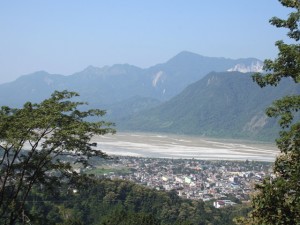
A panoramic view of Phuntsholing town
The Amo Chu, commonly is known as the Torsa river flows alongside this town and it is favorite spot for fisherman and picnickers. From Phuntsholing, the road winds north, over the southern foothills, through lush forested valleys and around the rugged north- south ridges of the inner Himalaya to the central valleys of Thimphu and Paro. It is a scenic journey; forests festooned with orchids cover the mountains on either side and exciting hairpin curves greet travelers with colorful sculptures of Tashi Tagye (the eight suspicious sign of Buddhism).
The scenic Wangduephodrang- sha Valley
Wangduephodrang- sha valley A 45-minute drive from Punakha is Wangduephodrang or Wangdue as it’s more familiarly known. At 4, 300 ft Wangduephodrang is distinguished primarily by its dzong, which completely covers the spur of a hill and commands excellent views of both the east-west and north-south routes. A bustling market with well-stocked shops and a pretty view over its own valley and Dzong. Wangdue is a good place to stretch your legs and wander around the shops before heading East.
Black Necked Cranes at Gangtey Gompa
Gangtey Gompa- Home of black Neck Cranes Spotting black-necked cranes in the meadows next to Gangtey Gompa is an ornithologist’s delight. Every winter, the rare and most beautiful black-necked cranes migrate from the high plains of the Tibetan plateau to Gangtey/Phobjikha valley where they are protected. The short journey South from the main East-West artery is well worth the detour for the dramatic change of scenery. Gangtey is an old monastery, inhabited only in Summer, a few hours’ drive from Wangduephodrang. A broad glacial valley (10, 000 ft) on the flanks of the Black Mountains, Phobjikha with its gently sloping hillsides is a place of astonishing beauty described as “the most beautiful valley in the most beautiful country in the Himalayas”. Gangtey also has a very interesting Nyingmapa monastery, the only one of its kind west of the Black Mountain range.
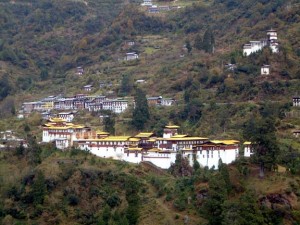
The Trongsa Dzong, Ancestral Home of The Bhutan Royal Family
Trongsa – crossroads of the Kingdom Ancestral home of Bhutan’s ruling dynasty and site of Bhutan’s most impressive fortress, Trongsa is a strategically located town on the east-west route.Sloping down the contour of a ridge stands the many-levelled Trongsa Dzong, built In 1648. The Dzong acts as a defensive fortress, stepping down into the valley and its bright golden yellow roof occupies most of the view from Trongsa. The Crown Prince of Bhutan traditionally becomes Penlop or Governor of Trongsa before being crowned King.
Trongsa has been the traditional home of all four kings of Bhutan prior to their ascending the throne. Trongsa’s location in the geographic centre of the kingdom has enabled a Penlop to effectively control the entire East and West of the country from there.
Ta Dzong, or the watch tower which once guarded the Dzong from internal rebellion, stands impressively above the Dzong and provides a visitor with more insight into the historical significance of Trongsa in Bhutan’s history. The Ta Dzong, a cylindrical stone structure rising five storeys, was built in 1652 by Chogyal Minjur Tempa, a task entrusted to him by Zhabdrung Ngawang Namgyal. After more than 350 years, it has been resurrected into a classy museum, that represents a tasteful blend of tradition and modernity.The galleries showcase more than 200 rare and priceless artifacts, ranging from religious sculpture dating back to the 17th century, to the Raven Crown and Sword of the First King, and numerous other royal possessions, including a radio presented to the Third King by an American businessman in the 1950s. There is also a media room where visitors can watch a documentary on the history of the monarchy. The Ta Dzong was built in 1652. It is situated strategically above the Trongsa dzong and served as a watch tower for centuries.
Bumthang Spirituals valleys This beautiful valley encapsulates a rich culture, Sceni beauty and hundreds of mythis and legends. People often call Mine Switzerland. The drive from Trongsa to Jakar may only take about two hours but the change in scenery is dramatic. It is the straightest section of the entire length of the road from Paro in the West to Trashigang in the East – a distance of about 610 Kilometres.
The hills around Jakar are filled with monasteries dedicated to Padmasambhava who Is said to have cured an ailing ruler and introduced Buddhism to the valley. Bumthang is also home to one of the great Buddhist teachers, Pemalingpa, to whose descendants the present dynasty traces Its origins. Jambay Lhakang and Jakar Tshechu are host to one of the most spectacular festivals in October each year when on one evening of the festival, the monastery is lit by a fire dance to bless infertile women with children.
Ura The last valley in Central Bhutan, Ura Valley, is also the highest in Burnthang. Wide open spaces characterise the valley that sits In the shadow of the Thrumsingla pass, separating the East from the West of the kingdom. Ura village and its new monastery are a charming stop before the climb to the East. Cobbled streets and a medieval feel give Ura an unusual yet very attractive atmosphere. The old women of Ura still wear sheepskin shawls on their backs which double as a blanket and cushion.
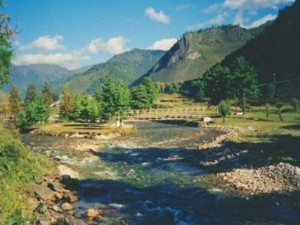
Mongar
Mongar – the journey East The differences between East and West Bhutan are far greater than the high pass that separates them. Perhaps like the Scots and the English, there are subtle but marked differences. History has played a significant role with the kingdom only being unified with the East at the end of the last century and prior to that many wars separated each side. The Eastern dialect Is so different from the Western dialect that the two groups find it difficult to understand each other.
Thrumsingla pass and a seven-hour drive separate Ura from Mongar in the East. The journey is one of the most beautiful in all the Himalayas. Rising out of Ura, the highway climbs steeply to the highest pass (3, 800 meters) along the West to East highway at Thrumsingla (during the Winter the pass can be closed for several days after heavy snowfalls) where the mountains of East Bhutan can be seen during clear weather. The descent from Thrumsingla to Lingmithang is astonishing for several reasons. The road drops from 3, 800 meters to 650 meters in only a few hours passing from pine forest through semi-tropical forest to orange groves. Carved out of the side of the mountain, in parts the road’s edge borders a sheer cliff which descends several hundred meters vertically with nothing to stop the fall.
Arriving at Mongar marks the beginning of your Eastern Bhutan experience. Towns in Eastern Bhutan are built on the sides of the hills which contrast to the West where they develop on the valley floor. Mongar Dzong was built In 1953 on the orders of the Third King, Jigme Dorje Wangchuck, The BTCL guesthouse is located near the Dzong enjoying a pleasant view from the garden over the Mongar Valley.
Trashigang Home of The thousand weavers Trashigang is the Easternmost point on the highway. Eastern residents use Trashigang to trade and the town itself is usually a hive of activity – especially around the bus station where buses are frequently leaving for Thimphu and Paro in the West and Samdrup Jonkar and India, only a few hours to the South. Trashigang is also a melting pot of hill tribe people who come in to the town to trade. In particular, the unusual Merak and Sakteng people come to Trashigang to trade yak’s butter for the provisions that they need in the mountains. Merak and Sakteng are located about 50 miles East of Trashigang close to the border with India’s Arunachal Pradesh. Trashigang Dzong sits on a jagged piece of land jutting out from the town and is the first land- mark that can be seen from the road winding up to Trashigang. The Dzong was built in 1659 and commands a spectacular view over the valley for which it is the administrative centre. The Dzong is significant for the fact that it only has one courtyard.
Samdrup Jongkhar-exit/entry point of Eastern Bhutan Located in the south-east of Bhutan, the border town of Samdrup Jongkhar is the eastern overland gateway to Bhutan. During winter months eastern Bhutanese come to this trading town to sell their hand-woven textiles and other wares.
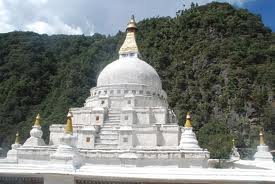
Gom Kora Temple
Trashi Yangtse The village of Doksum is a few kilometers past Gom Kora, a small temple on the side of the road. A large boulder sits In the garden of Gom Kora and it is said that if anyone can climb below the rock and emerge from its summit, he will be forgiven of his sins. Doksum is a weaver’s village where the women sit in fair weather on balconies with wooden slats strapped to their backs rocking back and forth to the rhythm of their looms. Tashiyangtse is a small village with a garden aspect and a lovely place from where to launch a couple of hour’s stroll into the surrounding countryside. Chorten Kora is one of the only two such stupas in Bhutan with styles similar. To those found in Nepal and is host to a great festival every March which attracts all of East Bhutan’s residents. The Chorten is entirely whitewashed and ideally situated next to a running brook.
13 Oct 2011
http://www.discoverybhutan.com/travelinfo.aspx
Average Rating: 5 out of 5 based on 283 user reviews.
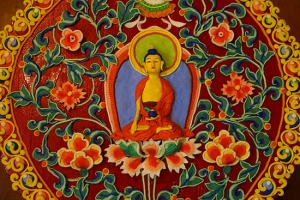 Butter Paint Taktsang Monastery
Butter Paint Taktsang Monastery